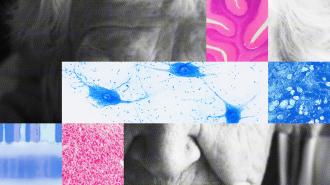This article is an installment of Future Explored, a weekly guide to world-changing technology. You can get stories like this one straight to your inbox every Thursday morning by subscribing here.
An estimated 55 million people are living with Alzheimer’s, an incurable brain disorder characterized by problems with memory and cognition. These symptoms get progressively worse, and most people with the disorder eventually lose their ability to live independently. Complications from Alzheimer’s killed 120,000 people in the US alone in 2021, making it one of the country’s top 10 causes of death.
Rather than having a single cause, many factors seem to contribute to the development of Alzheimer’s, including genetics — more than 70 genes have been linked to the disease. One common gene variant can triple your risk, and some rare mutations have been found that cause Alzheimer’s 100% of the time.
With such strong evidence that genes play a role in Alzheimer’s, it’s possible that gene therapy, including the powerful gene-editing tool CRISPR, could lead to new, better treatments for the disease — and two promising studies suggest that just might work.
Down with APP
Alzheimer’s dementia is driven by changes in the brain that lead to the death of neurons and their connections. These changes, which begin years before symptoms appear, include the accumulation of toxic plaques of beta amyloid protein between brain cells.
There isn’t a gene that tells cells to make beta amyloid. Rather, a gene called APP provides instructions to create the “amyloid precursor protein.” That protein gets broken down into smaller fragments, including beta amyloid, by enzymes in the body. Beta amyloid then forms into plaques, which (according to the leading theory) kill neurons and cause brain inflammation.
UC San Diego researchers set out to see whether the APP gene could be edited in a way that would lead to less beta amyloid and more of the other types of fragments, including soluble APP-alpha (sAPPa), which has been shown to protect and repair brain cells.
“Where we’re headed now is to find the best kind of way to target that human sequence.”
Brent Aulston
Using CRISPR and mouse models of Alzheimer’s, they discovered that snipping the end off the APP gene had the desired effect — researcher Brent Aulston told Neurology Live that the edit reduced the accumulation of beta amyloid in the brain by up to 60%, decreased brain inflammation by as much as 60%, and even restored cognitive abilities in the mice.
Backed by several grants, the team now plans to spend the next five years working to translate their CRISPR treatment to humans, with the hope of then moving into clinical trials.
“The gene sequence we target in mice is slightly different than the gene sequence we target in humans … so we’ve got to adapt our CRISPRs to target that specific human sequence,” said Aulston.
“Where we’re headed now is to find the best kind of way to target that human sequence — what is the best CRISPR enzyme that we can use that’s going to give us the most efficiency, the lowest off-target effects, all those different kinds of things,” he continued.
The Alzheimer’s gene
At the Alzheimer’s Association International Conference 2023 — the same conference where the UCSD research was presented — a team from Duke presented another Alzheimer’s/CRISPR study, this time focusing on the APOE gene.
There are a few different versions, or “alleles,” of this gene, which creates a protein that helps transport fats in the bloodstream. One version, called APOE-e4, is the strongest common genetic risk factor for Alzheimer’s.
About 25% of the population carries one copy of APOE-e4, inherited from one parent, and 2-3% carry two copies, one from each of their parents. While this alone doesn’t mean they’ll develop Alzheimer’s, having one copy of APOE-e4 can double or triple a person’s risk, and the risk is 8-12 times higher for people with two.
While researchers aren’t entirely sure why this allele increases Alzheimer’s risk, they suspect that the protein expressed by APOE-e4 could affect the brain’s ability to process fats.
“The findings are incredibly exciting”
Boris Kantor
Past studies found that removing or completely inactivating the APOE gene can have undesired consequences, so instead of using CRISPR to modify DNA itself, the Duke team modified APOE’s epigenome — the collection of chemical compounds around a gene that control whether it’s expressed or not.
In experiments on mouse models of Alzheimer’s and “mini brains” grown out of stem cells from an Alzheimer’s patient, the researchers showed how their CRISPR therapy could reduce the expression of the APOE-e4 gene without affecting the expression of other alleles, if those are present, too.
Because DNA isn’t directly altered with epigenetic editing, proponents believe it’s a safer way to use CRISPR in people. Much more research is needed before the Duke team’s therapy could be trialed in humans, but they are encouraged by the results they’ve seen so far.
“The findings are incredibly exciting,” said Boris Kantor, who presented the research at the conference. “They provide proof-of-concept evidence supporting our approach as a high potential new strategy to treat and possibly even prevent Alzheimer’s disease, which currently has no cure.”
Looking ahead
In the decade since researchers discovered that CRISPR could be used as a gene-editing tool, hundreds of teams have used it to develop medical treatments. Several have made it to clinical trials, and one for sickle cell anemia is nearing approval.
CRISPR’s ability to treat Alzheimer’s is still relatively unknown, though. While many groups, including those at UCSD and Duke, are developing promising CRISPR-based therapies targeting the many genes linked to Alzheimer’s, none have reached human trials yet.
“We envision a future where multiple treatments address every aspect of this most complex disease.”
Maria C. Carrillo
Due to the blood-brain barrier — a natural defense designed to keep pathogens in the blood from reaching brain cells — CRISPR therapies for Alzheimer’s could find it difficult, or impossible, to reach enough brain cells to have a therapeutic effect.
Techniques to get past this protective wall to treat other brain diseases are showing promise, though, so that might not be an insurmountable hurdle.
Still, less than 1% of Alzheimer’s cases are caused by a “deterministic” gene — a gene that inevitably causes the disease 100% of the time. The rest appear to result from a combination of factors, including age, lifestyle, environment, and genes with relatively more modest effects (like APOE-e4, which is present in about 40-65% of cases). So we’ll likely need a range of therapies to treat and prevent this devastating disorder.
“We envision a future where multiple treatments address every aspect of this most complex disease,” said Maria C. Carrillo, the Alzheimer’s Association’s CSO. “And that, once proven, the treatments can be combined in ways that complement and enhance each other to reduce risk, treat effectively, stop the progression, and eventually cure Alzheimer’s disease and all other dementia.”
We’d love to hear from you! If you have a comment about this article or if you have a tip for a future Freethink story, please email us at [email protected].






